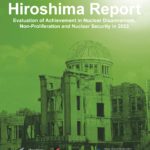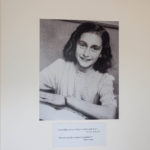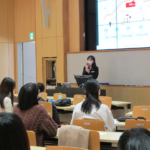3. Childhood Education
An opening ceremony for the Hiroshima Institute for War Children was conducted on January 19th, 1946. “31 young people were gathered under the generous protection of many people, including the director, Yamamoto Yoshinobu, and others.” According to a newspaper article published right before the opening, students woke up at 6 a.m. and started classes from 8:30, had lunch at 12:00, did agricultural work from 1:30, had a snack (such as milk) at 2:30, starting cleaning at 4:30, had dinner at 5:00pm, and went to bed at 8:00. There was “a field the size of a city block used by the Agricultural Test Center,” and “the school was self-sufficient in terms of food.” However, the students were wearing the same summer clothes that they had been wearing since the group evacuation had started. It was also reported that about 10 school teachers disinfected students with sulfur. The students did not have changes of clothes, and the clothes they had were infested with lice19. The school was established by a Buddhist named Yamashita, who had heard from his old friend Ikuzo Matsubayashi, chief director of the health division of Hiroshima City, about the plight of the children who had lost parents. He established the school with his own funds. Yamashita had been demobilized from the army on September 15th, 1945. He lost his second son in the atomic bombing.
Classes were conducted in a small branch school of Noborimachi Public School (present-day Noborimachi Elementary School), by Tadashi Tomasu, and his wife Yoshie, who was transferred from Hijiyama Public School. In the beginning, there was “only one 32-square meter classroom.” However, the environment was improved by relocating a dormitory, with the help of donations. The female faculty members lived together with the children, each charged with caring for six to ten children as “assigned mothers.” The children conducted Buddhist memorial services for their family members on the sixth day of every month, and also visited a Buddhist temple, Hikarigaoka Doshinji, every morning and night. The building had been converted from a dojo for spiritual training to a temple20.
However, the school was operating in straightened circumstances. Hiroshima City Mayor Shichiro Kihara, in a city report published on July 20th, 1946, called for burned-out fields to be turned back to agriculture and cultivated once more for the citizens. In Hiroshima City, delays and shortages of food were ongoing. Mayor Yamashita spent a large part of his personal assets to purchase black market rice, miso, and soy sauce to feed the hearty appetites of the children21. For medical treatment of eye infections and diarrhea, which were often contracted during the evacuation period, neighboring hospitals and practitioners contributed their support. The Institute for War Children was aided by the efforts and the willpower of those who were moved by a sense of mission.
Education for orphans of the atomic bomb did not only take place at the Institute for War Children. There were children who had no choice but to live independently due to the destruction and poverty wrought by the bomb, even if their parents had retrieved them in the aftermath.
Care for orphans returning from Japan’s former overseas territories began on October 22nd, 1945, using the retirement payments of Yorito Kamikuri, a former second lieutenant who established a camp for orphans repatriating from overseas, later called Shinsei Gakuen22. The school opened in a building which had once housed a barracks for a military transportation unit, located in Ujina-machi (present-day Minami Ward). By the end of the year, it accepted 220 children from Davao, Mindanao, Philippines, where there had been a school for Japanese children. The school also took in homeless children and established Shinsei Gakuen at a place that had once been used by soldiers of the 5th Field Artillery in Motomachi (present-day Naka Ward) on April 1st, 1947. In addition, on September 3rd, 1946, Hiroshima Prefectural Ninoshima School for War Orphans was opened on Ninoshima Island (present-day Minami Ward). 34 homeless children who had been caught by the police in the vicinity of the black market in front of Hiroshima Station entered the school23. Yoshimaro Mori, who was appointed the principal of the school, and Yutaka Yoshikawa, who had been demobilized from the army in China, made efforts to renovate Ninoshima Storehouse, formerly owned by a military transportation unit. At first, the children tried to escape the island on a raft, or by swimming. Hiroshima Monastery, which had cared for orphans before the war, resumed its activities in Wakakusa-cho, (present-day Higashi Ward), in April, 1947. In August, the Catholic Organization Hikarinosono Setsuri No Ie was established in Gion-cho (present-day Asaminami Ward), then, in June, 1948 it relocated to Motomachi and built a new building. The new building had five rooms with a space of 15 square meters each as well as a vocational center, and cared for 32 children24. Roppo Gakuen, an organization for mentally handicapped children, which relocated to Furutamachi Takasu in 1949, also accepted a-bomb orphans25.
In December, 1947, the Child Welfare Act was passed. Along with the Public Assistance Act passed the previous year, this ensured that facilities for war children officially became child-rearing institutions, and that the amount of subsidies they were eligible to receive thereby increased. However, the support was still insufficient. What allowed the institutions to operate were donations collected by the Red Feather Campaign, beginning in 194726. In 1949, proceeds from New Year’s cards with lottery numbers were also donated.
Beginning in 1948, the children of the Institute for War Children studied at local schools such as Itsukaichi Elementary School and at various junior high schools under the new system of education. According to the overview of the Institute for War Children, at that time, 85 children (25 of them girls), boarded at the school, with the breakdown as follows: 8 infants (3 of them girls), 48 children (14 girls), and 29 junior high school students (8 girls). Their reasons for boarding at the school included being a-bomb orphans (the largest cohort, at 67), homelessness (6), and being transferred from a Child Guidance Center (7)27.
Because of an offer by Yamashita, the Institute for War Children was transferred to Hiroshima City on January 1st, 1953. A total of 171 names are recorded in the log dating from the establishment of the institution to the transfer28. No children died during the period of food shortages. 23 children who were retrieved by parents, 46 by other relatives, and 70 children who were adopted, totaling, 86 children, left the institute by the end of 195029. In 1955, the institute was renamed Hiroshima City Doushinen, and ended its activities as a childcare institution in 1967.
Those who were called atomic bomb orphans left the institution and survived on their own as the reconstruction of Hiroshima City proceeded. To do things like marry or find work, they were forced to fight against prejudice.
19 The Chugoku Shimbun, January 16, 1946
20 Referred to Ikusei Nisshi (Education Diary) and a serial report “Ikinuita 30nen (30 years of Survival)” appeared in the Chugoku Shimbun from August 7-16, 1975
21 Yoshinobu Yamashita, Ikusei no Jakkan no Kiroku (Piece of Education Record), the Chugoku Shimbun, August 9, 1975
22 Hiroshima Prefecture (ed.), Hiroshima Kenshi: Gendai (Hiroshima Prefectural History: Contemporary), Hiroshima Prefectural, 1983, pp1135-1136
23 Hiroshima City Hall (ed.), Genbaku Sensaishi Dai 1 kan (Hiroshima City History of A-bomb Damages vol.1), Hiroshima City Hall, 1971, pp211-212
24 The Chugoku Shimbun, June 6, 1948
25 The Chugoku Shimbun (ed.), Honou no Hi kara 20 nen: Hiroshima no Kiroku 2 (20years after Fire of Flames: Record of Hiroshima 2), Miraisha, 1966, p296
26 Hiroshima Prefectural Council of Social Welfare, Hiroshima-ken Shakai Fukushi Jigyou No Gaiyou (Report on Hiroshima Prefecture Social Welfare), March 1955, p88
27 Hiroshima Institution for War Children, Youran Showa 24, 25 nendo ban (Overview:1949 and 1950) owned by Hiroshima Peace Memorial Museum
28 Hiroshima Institution for War Children, Jidou Meibo (List of Students) December 26, 1945 to November 19, 1951
29 Hiroshima Institution for War Children, Youran Showa 24, 25 nendo ban (Overview:1949 and 1950) owned by Hiroshima Peace Memorial Museum








